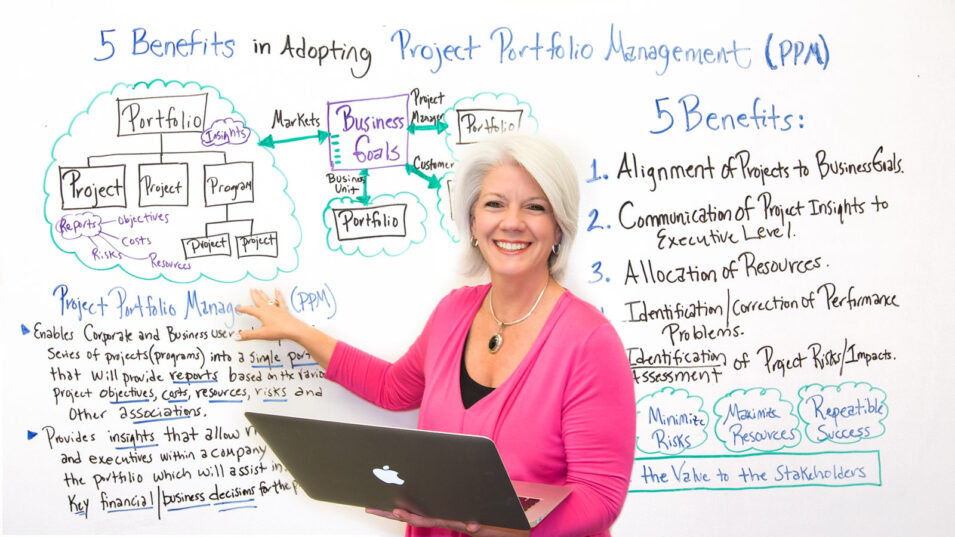Do you feel overwhelmed by the number of projects your team has on its plate? With Project Portfolio Management, you can better manage those initiatives and ensure your team is working on the right ones.
In this guide, we’ll cover the best practices and key concepts of project portfolio management to help you get started. Get ready to bring your project management skills to the next level!
Benefits of Project Portfolio Management

Project portfolio management (PPM) is the strategic process of balancing the demands of stakeholders against corporate capabilities to ensure that all projects in the portfolio are executed and delivered successfully. It involves aligning goals, objectives, and resources with businesses’ overall vision. While there are several PPM software options available, using a platform like WorkOtter can streamline the process and provide a centralized location for all project management activities. When implemented correctly, the benefits of PPM can be substantial for organizations.
PPM helps organizations prioritize different initiatives based on their impact on achieving strategic objectives, increasing overall organizational effectiveness. It also enables them to make more informed decisions about capital investments and project pursuits. In addition to these tangible benefits, PPM provides organizations with a way to understand overall project performance and gain visibility into project-based efforts across departments or divisions; as well as understanding trends in resource allocation or utilization. Organizations can also better identify risks associated with individual projects or within their entire project portfolios. Having this knowledge allows them to take steps necessary to mitigate those risks before they lead to significant issues down the line.
Moreover, it helps organizations track costs associated with projects and balance those costs against expected returns on investments (ROIs); allowing companies to maximize its use of resources while minimizing risks and inefficiencies across its portfolios. The bottom line is that strong project portfolio management ensures that organizations are able to deliver greater value from every initiative by optimizing processes related from strategy definition through execution; driving business success more quickly than ever before!
Best Practices for Project Portfolio Management

By leveraging key best practices in the area, organizations can ensure that their projects operate smoothly with fewer delays and fewer costs.
The most successful organizations combine both strategic planning with the execution of project-level activities to ensure success. A set of core principles form the basis of their PPM best practices:
Goal-oriented Planning: Establishing a clear mission statement and objectives for each project, as well as understanding how investment decisions will align with strategic goals.
Prioritization: Organizing all operational activities into a unified portfolio, then evaluating which projects should have priority based on available resources, time constraints, risk factors, and business value.
Balanced Resource Allocation: Assessing resource availability across the entire portfolio to ensure optimal utilization of personnel and tools throughout the lifecycle of a project or initiative.
Risk Analysis: Identifying potential risks associated with specific projects before committing resources or dollars to investments or initiatives.
Strategic Project Financing: Determining an appropriate funding pathway and sources to support planned projects while achieving desired outcomes within budgeted constraints.
Adaptive Project Execution & Management Practices: Adapting standards, methodology, process approaches and performance measurement models when necessary to meet changing project requirements over time.
Continuous Improvement & Quality Assurance Processes: Establishing processes for regular evaluation that assess productivity gains or losses as well as continual identification/resolution of quality issues at all stages of development/deployment.
Common Challenges in Project Portfolio Management

As with all management systems, there are several common challenges that organizations may face. Poorly defined project objectives can be a problem; if there is no clear definition of success then it’s impossible to recognize where the project should be going or what milestones must be achieved in order to reach its intended purpose.
Inadequate resources can also hinder progress as well as miscommunication between team members and departments resulting in different expectations from both sides which affects progress toward reaching objectives and goals. The budgeting process needs to be agreed upon in advance along with setting out clear strategies on how resources will be managed for each individual project to meet its end deliverables in time and within budget expectations. Finally, resistance from departments who think their projects have more priority than others poses another challenge that management must address by having a full understanding of every department’s needs during the planning stages.
Implementing Project Portfolio Management
By taking into account the importance of both resource utilization and prioritization of projects, organizations use PPM to make sure they are running the most suitable and efficient operations.
Implementing project portfolio management can involve several components to ensure its success. Here are just a few:
- Establishing criteria: Organizations must first fully define their criteria for choosing which projects to invest in. A clear definition of selection criteria can help better assess which projects are worthwhile and effective for the organization’s goals.
- Selecting and prioritizing projects: Organizations must identify a process for how best to choose from submitted projects and decide which should be prioritized based on their comparative value against established criteria.
- Allocating resources: To ensure that the selected projects will be successful, resources such as staff members, money, materials, and equipment are allocated appropriately prior to launch.
- Tracking project status: Once launched, tracking project milestones is one way of ensuring that teams stay on track toward reaching their goals within desired timeframes and with expected budget ranges. This may involve regular reporting so that stakeholders can assess where additional resources may be required if needed as well as making any necessary mid-project changes or adjustments between teams or stakeholders.
Using these steps along with other possible implementation components such as scope changes, risk assessment/management or creating an exit strategy can allow managers to gain better insight into the success rate of their chosen portfolios while minimizing potential risks associated with long term investment decisions.
Conclusion
By creating an effective framework for project portfolio management and applying best practices with key concepts throughout different life cycles consistently, organizations can successfully apply their efforts in managing multiple initiatives at once while creating a better strategy for future projects.










